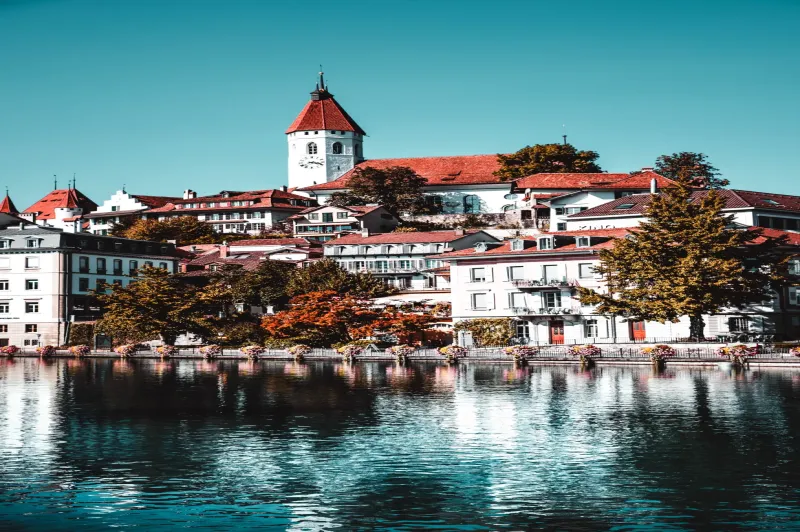
The Thun is a lake in the canton of Bern in Switzerland. It has an area of 29.8 km2 and is 23.6 km long and 1.8 to 2.4 km wide. Its maximum depth is 145 m.
The city of Thun was founded in 1191 by Duke Berthold V of Zähringen. It quickly became the capital of his newly created Zähringerland, and prospered as a market town and commercial center. In 1264, Thun was destroyed by fire and rebuilt in a new location. In 1384, Thun joined the Swiss Confederation, and in 1518 it was made a free imperial city by Emperor Maximilian I.
During the Reformation, Thun became a Protestant city, and in 1525 its citizens threw out the Catholic mayor. In 1640, Thun was conquered by the Bernese, and it remained under Bernese control until 1798. In 1803, Thun became part of the canton of Bern, and it has remained in Bern ever since.
Today, Thun is a thriving city with a population of over 43,000. It is a popular tourist destination, known for its medieval Old Town, its picturesque setting on Lake Thun, and its many cultural and outdoor activities.
Read more >> Explore the Historic Forts of Maharashtra A Guide
Top 7 visiting Places In Thun
1. The Old Town of Thun
Thun is a town and a municipality in the administrative district of Thun in the canton of Bern in Switzerland. It is located where the Aare river flows out of Lake Thun, 30 kilometres (19 miles) south of Bern. As of December 2019, the municipality had a population of 43,292 inhabitants.
2. The Aare River
The Aare River is a tributary of the Rhine and is one of the major rivers of Switzerland. The Aare is the longest river in Switzerland and is about 290 kilometers (180 miles) long. The Aare River flows through the cantons of Bern, Aargau, Solothurn, and Basel-Landschaft. The Aare River starts in the Grimselsee, which is a lake in the Bernese Alps.
3. The Thun Castle
Thun Castle is a castle in the city of Thun in the canton of Bern in Switzerland. It is located on a promontory on the left bank of the Aare river. It is a Swiss heritage site of national significance.
The castle was built in the 12th century by Duke Berthold IV of Zähringen. It was the seat of the local rulers until the 16th century when Thun came under the control of the city of Bern. The castle was expanded and renovated several times over the centuries. It was used as a barracks in the 9th century and was restored in the early 20th century.
The castle has three main buildings, the keep, the Great Hall, and the chapel. The keep is the oldest part of the castle and is four stories tall. The Great Hall was built in the 13th century and is the largest room in the castle. The chapel was built in the 16th century.
The castle is open to the public and contains a museum with exhibits on the history of Thun and the castle.
4. The Niederhorn Mountain
The Niederhorn is a mountain in the Bernese Oberland in Switzerland. It is located west of the town of Thun, between the valleys of the Simme and the Lütschine. The summit can be reached by cable car from Beatenberg or by a hiking trail from Vorsass. The Niederhorn is a popular destination for day trips and hiking. The views from the summit are some of the most beautiful in the Alps.
5. The Stockhorn Mountain
The Stockhorn is a mountain in the Bernese Alps in Switzerland. It is located between the valleys of the Kander and Simme rivers. The summit is 2,190 metres (7,200 ft) above sea level and is accessible by cable car from Zweisimmen and by mountain railway from Grindelwald.
6. The Lake of Thun
The Lake of Thun is a freshwater lake in the canton of Bern in Switzerland. The lake has an area of 29.4 square kilometres (11.4 sq mi) and is fed by the Aare River.
7. The Konizberg Mountain
The Konizberg Mountain of Thun in switzerland is a popular tourist destination. The mountain offers stunning views of the Swiss Alps and is home to a variety of wildlife. Konizberg is also home to a number of ski resorts, making it a popular destination for winter sports.








Showing 0 verified guest comments